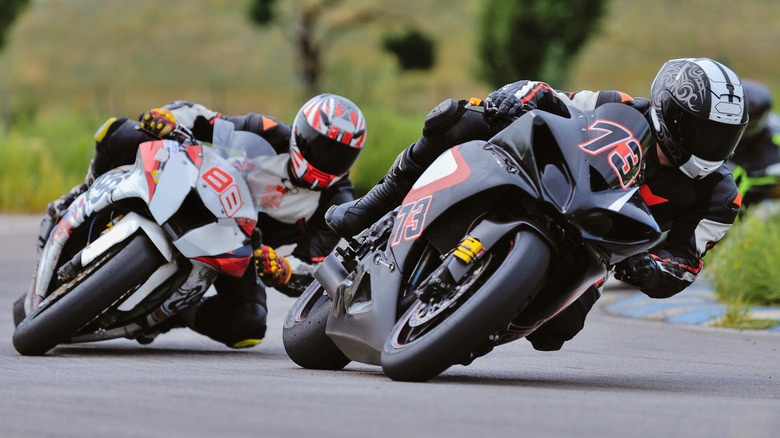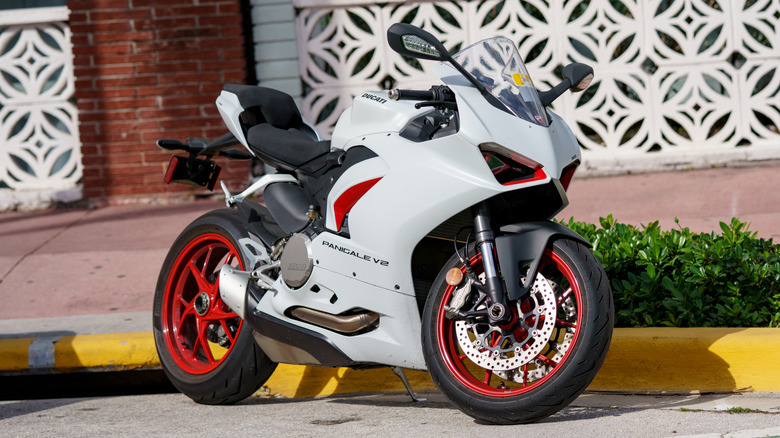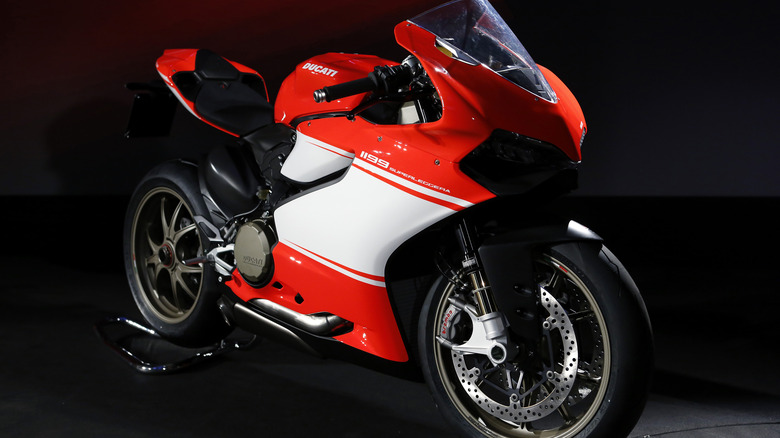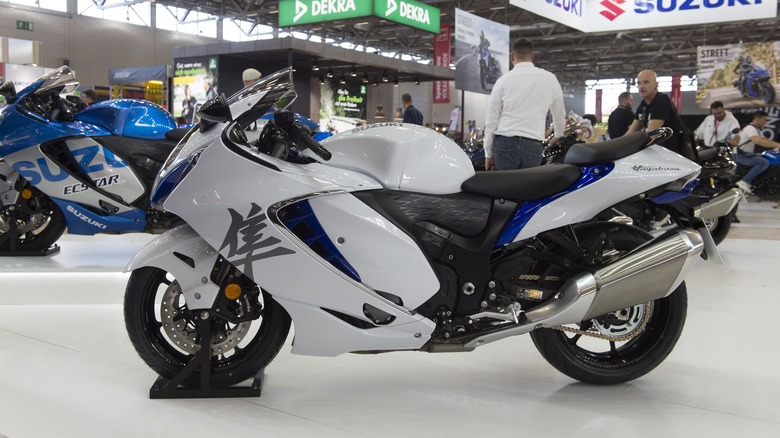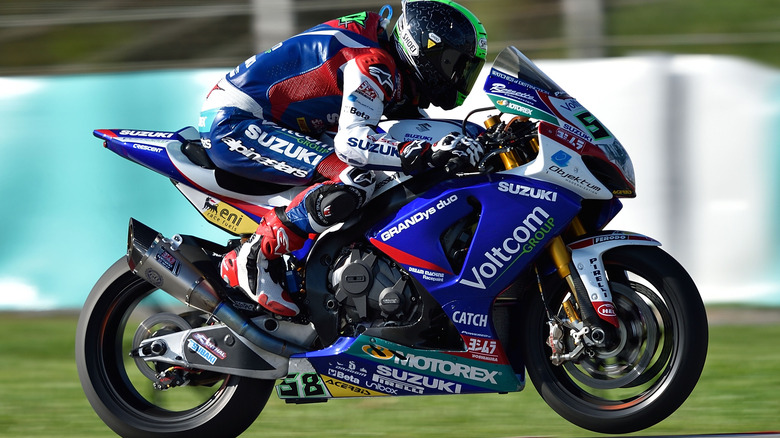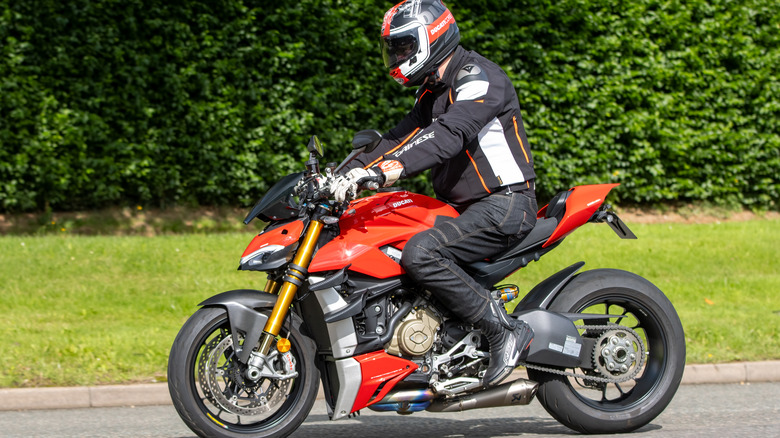Ducati Vs Suzuki: Who Makes The Better Sport Bike?
Ducati and Suzuki are two of the biggest names in sport bikes, and if you're in the market for a new ride, you may find yourself torn between the brands. Ducati was founded in Italy nearly a century ago and is headquartered in Bologna. Ownership of the company has traded hands several times, and it's currently owned by luxury auto manufacturer Lamborghini, which is a great fit considering that the Ducati name goes hand-in-hand with higher-end premium motorcycles.
Suzuki is no less known in motorcycle circles, but it's not as synonymous with luxury as the European brand. Suzuki is a little older than Ducati and was founded in Japan, where it's still headquartered. The company started out making machinery rather than cars and bikes, which may be why — like several other Japanese manufacturers — the brand is associated more with more affordable models and more reliable engineering than with flashy luxury. That doesn't mean Suzuki sport bikes are hum-drum by-the-numbers two-wheelers, however. In many ways, Suzuki sport bikes are quite similar to Ducati, although they certainly have their share of differences.
So which company makes the better sport bike? The answer isn't really black-or-white but rather comes down to what specifically you're looking for in a motorcycle.
Suzuki and Ducati offer a similar range of sport bikes to choose from
Both Ducati and Suzuki offer customers a wide range of sport bikes to select from. Ducati's current lineup of sport bikes includes high-performance models such as the Hypermotard 950, Monster Plus, Streetfighter V4 S, Superleggera V4, and the SuperSport 950 S. These base models are often accompanied by subvariants such as the Ducati Streetfighter V4 Lamborghini, which we named one of the best motorcycles Ducati has ever built.
Suzuki also has no shortage of options when it comes to sport bikes, though the models are more similar to one another, so the overall lineup is a little less diverse. Some of the models it currently offers are the Hayabusa, GSX-R1000, GSX-R750, GSX-R600, and GSX-250R ABS. Likewise, these Suzuki models are accompanied by several sub-variations. This includes bikes like the GSX-R1000RZ, GSX-R750Z, GSX-R600Z, and Hayabusa 25th Anniversary Edition.
Ducati has some bikes similarly-priced to Suzuki, but much more expensive models also
Ducati is a luxury brand and customers expect to pay a premium for bikes made by the company. Some bikes command incredible prices, like the Ducati Superleggera V4, which starts at $100,000. Thankfully, many of its motorcycles are situated somewhere in a more reasonable price range that is in line with other companies.
Ducati Monster bikes and Ducati Hypermotard bikes are generally available for less than $20,000. The Monster Plus starts as low as $12,995 and the 30th Anniversary model is almost $6,000 more. The Ducati Panigale line has an even wider range of prices, with the Panigale V2 starting at a base price of $18,595 and the Panigale V4 R costing $45,495. Various specialty models will go for more, however, such as the 2023 Panigale V4 Moto GP World Champion Replica which costs $63,000.
Suzuki, meanwhile, generally makes more affordable sport bikes. The GSX-R600 and GSX-R750 models start at prices ranging between $11,899 and $12,949. Pricier bikes made by Suzuki, like the Hayabusa and the GSX-R1000R, still have relatively modest retail costs — the Hayabusa starts at $19,099 and the GSX-R1000R at $18,499. Plus, anyone looking for a sport bike that's even cheaper than these is in luck because the base price of the Suzuki GSX250R ABS is only $4,999.
Ducati bikes are generally more powerful, but not all of them out-perform Suzuki
In general, Ducati is known more for the performance of its sport bikes than Suzuki is, but that doesn't mean Suzuki's bikes have poor engines. Suzuki's 2024 Hayabusa, for example, has a 1,340 cc inline four-cylinder, liquid-cooled dual overhead camshaft engine. It uses ride-by-wire throttles that trigger fuel injection technology and utilizes a durable, relatively straightforward six-speed, close-ratio transmission that's been developed to match the performance of the Hayabusa's engine.
Even the engine of one of Ducati's lower-performance bikes still compares well to some of Suzuki's best, however. The Panigale V2 uses Ducati's Superquadro engine, which has four valves per cylinder. Its 955 cc V-twin engine can generate 155 horsepower and 77 ft-lbs of torque at 9,000 rm. It's a solid sport bike, even if it doesn't match the full performance of the Suzuki Hayabusa and other higher-end models.
However, when matching each company's best, Ducati wins out. The Panigale V4 runs on a Desmosedici Stradale engine that can deliver 215.5 horsepower and a torque of 12.6 kgm at 10,000 rpm, which is some truly impressive specs for a sport bike.
Suzuki bikes are more reliable than Ducati
Japanese auto manufacturers are known for building reliable vehicles, and that include major motorcycle brands like Honda, Yamaha, Kawasaki, and Suzuki. Conversely, while Ducati has a reputation for powerful, premium motorcycles, it's also known as being less of a reliable brand. But do actual statistics confirm or refute these reputations? In general, the answer is yes. According to data compiled by Consumer Reports, Suzuki bikes have an overall failure rate of 12 percent. Only Yamaha has a better reliability score — and just barely — with a failure rate of 11 percent.
Meanwhile, Ducati has a failure rate of 33% when using the same reliability scale. While that puts it above some other well-known motorcycle brands — like BMW — it still means that one in three new bikes could pose a problem to their owners. While Suzuki's bikes might not have the performance peaks of Ducati's, the manufacturer excels when it comes to engineering and has a solid reliability record to show for it. If you're looking for a bike that will last, you may want to go with Suzuki over Ducati.
Both brands offer innovative features
Many innovative features in newer bikes' electronic systems were pioneered by Ducati, but brands like Suzuki have since caught up, making the former stand out less. Ducati was the first sport bike manufacturer to introduce traction control, LED front lighting, engine brake control, slide-by-brake, radar adaptive cruise control, and blind spot detection, among many other important performance and safety features. Ducati's engineers are continually improving and adding more as well, making the line of sport bikes one of the most advanced.
However, since newer Suzuki bikes will have many of the same features pioneered by Ducati a few years earlier, you can expect a similar level of safety and technological advances from more recent Suzuki models. The higher-end Suzuki GSX-R1000R, for example, comes with impressive features like a 32-bit dual processor engine control module, LCD multifunction instrument panel, and motion track anti-lock brake system.
Every model is different, but if you're comparing Suzuki and Ducati sport bikes, you can assume that newer models are similar when it comes to advanced electronic and safety features. That said, when it comes to older models, it's likely Ducati will have more sophisticated systems.
